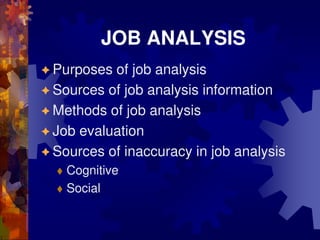Job analysis
- 1. JOB ANALYSIS Purposes of job analysis Sources of job analysis information Methods of job analysis Job evaluation Sources of inaccuracy in job analysis Cognitive Social
- 2. What is job analysis? Definition: a method for describing jobs and the human attributes necessary to perform them Two approaches: job oriented person oriented
- 3. Purposes of Job Analysis selection legal issues performance appraisal career development training
- 4. Sources of Job Analysis Information Who provides information? subject matter experts (job incumbents and supervisors) analysts How is information collected? Performing the job Observing incumbents perform the job Interviewing SMEs Surveying SMEs
- 5. Methods of Job Analysis Task inventories Time spent on task Importance of task, difficulty of learning Functional Job Analysis data people Things Critical incidents technique
- 6. Methods, cont. Job Components Inventory Tools and equipment Perceptual and physical requirements Mathematical requirements Communication requirements Decision making and responsibility Position Analysis Questionnaire Information input Mediation processes Work output Interpersonal activities Work situation and job context Miscellaneous aspects
- 7. Job Evaluation Definition -- family of quantitative techniques used to determine the salary levels of jobs Why is job evaluation important? Equal Pay Act of 1963 Comparable Worth
- 8. Job Evaluation Methods Ranking -- rank order the jobs according to each jobs relative worth or value to the organization Classification -- placing all jobs into a predetermined taxonomy of grades or classes (like the DOT) Point systems -- assign points to various levels of skill, knowledge, responsibility, working conditions, then summing the points.
- 9. Summary Purposes of job analysis Sources of job analysis information Who provides information? How is information collected? Job analysis methods Job evaluation – purpose and methods
- 10. Inaccuracy in Job Analysis JA assumes information is reliable and without error Sources of Inaccuracy Social – Created by normative pressures from the social environment Cognitive – Limitations on ability to process information
- 11. Effects of inaccuracy on job analysis data Interrater reliability Interrater agreement Discriminability between jobs Dimensionality of factor structures Mean ratings Completeness of job information
- 12. Social sources of inaccuracy Social influence processes Pressure to conform Extremity shifts Motivation loss social loafing free riding Self-presentation processes Impression management Social desirability Demand effects
- 13. Cognitive sources of inaccuracy Limitations in information processing systems Information overload Heuristics Representativeness Availability Anchoring and adjustment Categorization
- 14. Cognitive sources (cont.) Biases in information processing systems Carelessness Extraneous information Inadequate information Order and contrast effects Halo Leniency and severity Method effects
- 15. Minimizing Inaccuracy Obtain job info from multiple sources Use a variety of research methods Make process clear and understandable for the respondent Supervise data collection closely Pilot studies Monitoring questionnaire completion Debriefing respondents
- 16. Summary Effects of inaccuracies on job analysis data Social sources of inaccuracy Social influence processes Self-presentation processes Cognitive sources of inaccuracy Limitations in information processing Biases in information processing Minimizing inaccuracies

